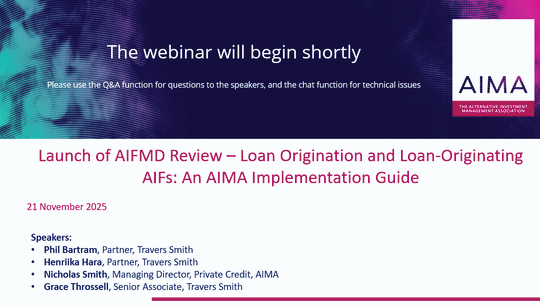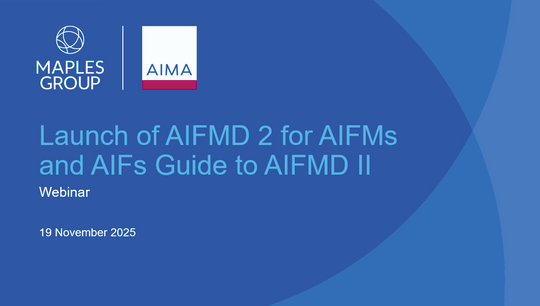Regulatory guidance on fund costs
By Mark Browne, Clerkin Lynch LLP
Published: 18 September 2023
Costs and charges paid by funds have become a key focus of regulators in Europe in recent years. A recent letter from the Central Bank of Ireland (the Central Bank) to the chairs of relevant boards outlines some specific actions to be undertaken to ensure compliance with the governance obligations pertaining to this topic (the Costs and Fees Letter). This letter provides useful general guidance regarding addressing related issues including for managers and funds subject to alternative regulatory oversight.
Background
Citing concerns at the detrimental impact of costs for retail investors in particular, the European Securities and Markets Authority (ESMA) issued a briefing entitled “Supervisory Briefing on the Supervision of costs in UCITS and AIFs” on 4 June 2020 (the ESMA Briefing). It subsequently named costs and fees charged to funds as one of its two supervisory priorities to be addressed for 2021 and, noting the related requirements in both the underlying UCITS Directive and AIFMD as well as relevant supplementary provisions in the Level 2 legislation, announced it was launching a common supervisory action (CSA) across the EU to assess related matters including compliance with the obligation to ensure funds were not paying undue charges. This background is further explained and explored in greater detail an earlier article on this topic Scrutiny due for undue charges, also by Mark Browne, published in the AIMA Journal 28 June 2021. ESMA’s final report on the CSA was published on 31 May 2022 (the Final Report). This was followed on 17 May 2023 by the release by ESMA of an Opinion on Undue Costs of UCITS and AIFs which proposes updating the underlying primary legislation to be more prescriptive on related matters and to further supplement this by means of Regulatory Technical Standards (RTS) which will detail the circumstances where costs are to be deemed undue costs and circumstances where additional costs may be permissible. These recommendations have in turn been followed up on by the European Commission by including relevant provisions in the draft Retail Investment Package released on 24 May 2023.
The costs and fees letter
The Costs and Fees Letter reflects the findings of the Central Bank from its actions on foot of the CSA and it should be considered in conjunction with the Final Report. This letter was issued in late March 2023 with a stated expected compliance date of quarter 3 2023 for plans to be put in place to address any related deficiencies identified. It was addressed to the chairs of Irish authorised UCITS but has broader application as it states that “it is the expectation of the Central Bank that the findings and actions of this review are also considered by AIFMs with respect to cost and fees charged to AIFs” and the respective underlying pieces of legislation contain similar obligations regarding both categories of funds.
Supervisory expectations and related guidance
The Costs and Fees Letter has six main findings, several of which have general application.
Firstly, there is a general expectation that all relevant firms should have structured, formalised pricing policies and procedures in place. These should include clear oversight and approval processes from senior management to facilitate the transparent identification and quantification of all costs charged to each fund as well as related controls over these. A failure to maintain detailed and documented policies and procedures to govern the calibration and imposition of costs and fees would give rise to a risk that the control environment for costs and fees is ineffective and increases the potential for undue costs to be imposed on investors.
Secondly, there is a requirement for the periodic review of costs and fees on a planned and systematic basis. It is inadequate to solely approve fee structures on establishment or launch and not continue to keep them under review during the life of a fund. Furthermore, such reviews should take account of the investment objective and strategy of the fund, the target and actual level of performance achieved and the role and responsibilities of service providers. The viability of the fund should also be considered in this regard and the potential to generate not only a positive return for investors but one commensurate with the risk profile of the fund should be taken into account.
Thirdly, the design process and ongoing oversight of fee structures should also be the subject of appropriate policies and processes. It is not acceptable from a governance perspective to merely rely on delegate investment managers to determine the pricing structure of funds without proper engagement with boards and subsequent ongoing oversight of the pricing process. Accordingly regular reporting and review is an essential component.
Fourthly, the analysis of costs and charges should be holistic in nature and ensure that potentially hidden costs such as revenue from, or costs for, services connected to techniques such as Efficient Portfolio Management (which are often provided by firms associated with the investment manager) are also included in the scope of related analysis and addressed in the policies and procedures and in sufficient detail.
Fifthly, there should be an obligation to look under the hood of the constituent costs for services provided as part of Fixed Operating Expense Models (FOEM) and to include such analysis in the periodic review process. While FOEMs have the benefit of providing investors with protection and certainty with respect to the maximum fees being incurred, there should be awareness of all underlying expenses and the model should be calibrated so that the differential of any excess above the amalgamation of appropriate constituent fees is minimised to avoid undue costs being charged to investors.
Finally, firms should ensure that the fee arrangements are appropriate for the services provided. One area of concern in this regard relates to investment advisors with only a non-discretionary advisory role being paid a greater fee than the delegated investment manager. This practice raises concerns as to actual nature of the role of the investment advisor and whether relevant fees have been negotiated in the best interests of investors. It would also give rise to concerns that this party is acting with more influence and control than is appropriate given its actual role.
Further considerations
While regular periodic reviews are to be expected, consideration should be given to including a requirement in the policies for reviews to be undertaken on an ad hoc basis on the occurrence of certain tigger events, such as a significant change in fund size for example as a result of a large redemption or market correction, a shift in market dynamics such as significant adjustments to interest rates or foreign exchange rates etc. Naturally it would be appropriate for any such triggers to be relevant to the nature of the fund and its cost base.
The stated requirement for ‘independent’ reviews as part of this process is interesting and may require a two step process to be put in place to ensure this element is satisfied. In particular, while in many cases management companies will be expected to perform such analysis in the first instance since they are the ‘responsible person’ under relevant legislation, they may not be regarded as independent given that they are responsible for appointing delegates and they themselves are beneficiaries of fees from the underlying funds. Accordingly, it will be appropriate for analysis to be undertaken at fund board level, ideally with the benefit of external data from third party data providers to assist in gauging relative costs and expenses for similar products.
Conclusion
The Costs and Fees Letter provides useful guidance regarding governance steps to be put in place to ensure appropriate oversight of fee related matters. It has general application in this regard for all fund boards rather than merely those it was directly addressed to. Adherence to the steps outlined in this letter can help ensure management are following best practice in the industry as well as providing documentary evidence of this. As such this can assist in providing a solid defence in the event of any future related regulatory investigations or shareholder suits.







